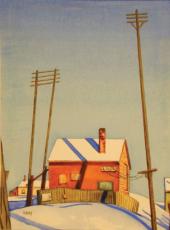

Robert Hurley was widely recognized in Canada for his watercolour paintings of the prairie landscape. Hurley's intimate relationship with Saskatchewan's landscape lasted more than forty years and spawned thousands of paintings. He has been called Saskatchewan's “sky painter” for his effective use of watercolour to illuminate the prairie sky, a dominant motif throughout his collection. Born on March 26, 1894, in London, England, Hurley was intrigued by art - particularly watercolours - as a teenager and often visited London's famous galleries. He worked as an apprentice printer-compositor until he was summoned for duty in World War I. In 1923, after returning from the war, he immigrated to Canada to work on the Canadian Pacific Railway near Milden, Saskatchewan. Later that year, Hurley moved north to Saskatoon and found seasonal employment in local gardens and lumber camps. Inspired by the unadorned prairie landscape, he began his career as a professional artist. During the Depression, he could not afford sketching paper or paint, and instead used newspaper print, toothbrushes, and berry extract to render his first sketches of the river valley near Saskatoon. Uncomfortable with the irregularity of the valley terrain, Hurley turned to the open plain and embraced its geometric simplicity. By 1940, his numerous landscape paintings had garnered national attention: he had quickly distinguished himself in Saskatchewan and Canada for his portrayals of prairie light and space, and for his flat, linear treatment of the landscape. He used broad colour washes to illustrate a vast prairie sky and explicit linearity to depict grain elevators, telephone poles, roads, railways, and the horizon - classic prairie elements that appear in most of his works. Hurley was a self-taught painter fulfilling a beloved pastime. His only formal training was from 1933 to 1935 at the Saskatoon Technical College, where he studied under prominent Austrian-born painter Ernest Lindner. Hurley's watercolours have been featured in exhibitions and collections across Canada, including the 1971 Watercolour Painters from Saskatchewan exhibit at the National Gallery of Canada. He retired in 1958 and moved to Victoria in 1963. A prolific artist throughout his lifetime, he continued to paint until his death on March 24, 1980.
Iain Stewart